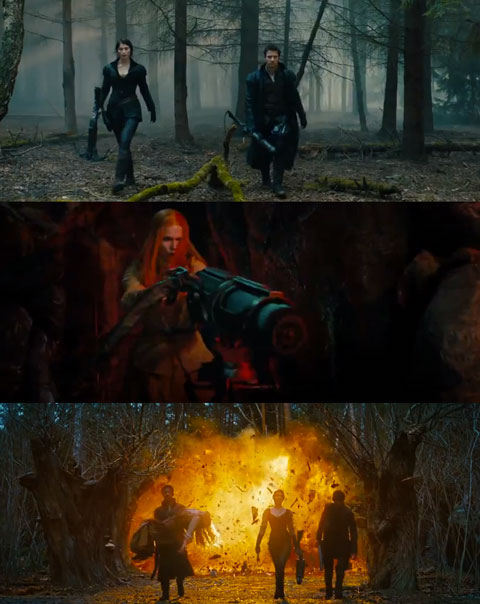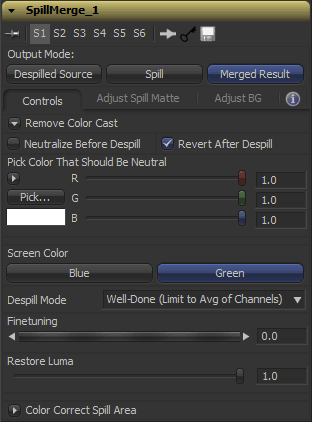Nichtlustig Crowd-Funding
Ich bin großer Fan von Joscha Sauer’s Webcomic “Nichtlustig”. Fast zu spät habe ich jetzt erst mitbekommen, dass er ein Crowd-Funding-Projekt laufen hat, um eine Pilotepisode für’s Fernsehen zu produzieren. Die ersten 10 Minuten sind schon fertig und über 8000 Leute haben sich bereits beteiligt:
http://youtu.be/pVZou6ZDsbo
Joscha’s Finanzierungsaktion läuft noch bis zum Jahresende und jeder Spender bekommt auch was zurück, wie’s beim crowd-funding üblich ist. Angefangen von der 1. Folge als Download für 1€ bis zum Co-Produzentenlevel.
Da es ja eh zu wenig Trickfilm-Experimente im deutschen Fernsehen gibt habe ich ihn gleich mal mit 25€ unterstützt. Bin gespannt auf die exklusive DVD mit Audiokommentar 🙂
Hänsel & Gretel: Witch Hunters
HO – LY – SHIT. That one looks like it’s gonna be fun 🙂
Or… it could suck like all the other movies of that genre that try to re-invent fairy tale characters in a world tainted by the Twilight saga (“Red Riding Hood” comes to mind but also “Van Helsing” although it predated this decade’s vampire craze). But at least “Hansel & Gretel” looks like it’s going to be honest: no hollow claims of answering questions about the origin of life (“Prometheus”) or re-inventing time travel (“Looper”).
Just “this is what Hansel & Gretel would look like in a steam-punk movie for teenage boys. Hell yeah!” *
Who knows if it’s gonna be good. Maybe it’s witty like “Brothers Grimm”, maybe it’s trashy like “Underworld” or “Resident Evil”. But with stills like these, it’s definitely on my watchlist even though this mentality has led to disappointment most of the time 🙂

The VFX look much much better than in Resident Evil though. That hero shot at the bottom looks really well done. Light is engulfing the actors quite nicely and although a real explosion would be even brighter the actors are underexposed enough to sell the shot.
Compare this to a shot from the Resident Evil trailer I’ve criticized in the past where the integration of explosion and environment is abysmal.

For people who are not so much aware of what constitutes effects shots nowadays (and why movies get more expensive all the time…): I’m pretty sure the fog in the topmost screenshot was added later on in postproduction. Even if there was such a forest with the right kind of humidity at the right time of day to produce a suitable fog, no sane producer would allow a shot of the main actors to be restricted by such unreliable weather conditions. Doing the fog in post also allows the director creative freedom to add details like those godrays. All it takes is a matchmoving artist, a bunch of roto slaves and a 4-digit amount of dollars. If the director requests half a dozen versions until he’s satisfied with the color and density of the fog, the VFX company probably won’t break even. That’s the state of the industry.
*) yeah, I’m using the term “steam-punk” loosely. But any movie that mixes gatling guns with 18th century German timber-frame construction qualifies as steam-punk to me.
Keying Window Reflections, Smoke and Explosions
This post is about a keying technique that saved my ass on a couple of difficult shots recently.
Most keyers are all about pulling a matte from a green or blue screen plate which is then used to merge a despilled image onto the desired background. This technique has its limitations though and who doesn’t know the tedious task of combining and layering several keyers in different parts of an image until the result looks right.
There are, however, keying issues that are hard to get right even by combining multiple keyers: things like glass or glow. Both phenomena are additive in nature – they add light on top of what’s reflected from the green screen into the camera lens – which makes them different from semi-transparent things like smoke or motion blur. In compositing terms this means that there is no proper alpha value for them but since they change the color of the green screen behind them (reflections on a glass window are a good example) traditional keying algorithms will calculate an alpha value > 0 anyways.
The technique I’d like to demonstrate is simple. I didn’t invent it, by the way. I first came across it in a post from the Shake mailing list years ago but didn’t fully understand it. A compositing artist on “Vanilla Sky” (if I remember correctly) said that he pulled a soft matte and used it to push the color-corrected background through the foreground, preserving grain and fine hair.
These are the steps you need to take:
- Use a color difference formula to pull a soft matte, which is similar to despilling: use the difference between green and the average of blue and red, or the difference between green and the maximum of blue and red.
- Instead of manipulating that matte until it’s fully black and white, use it as it is to add the background image onto the (despilled) foreground image. This will lead to a strange low-contrast mix of foreground an background. But here’s the trick:
- Crank up the contrast of the background image until the result looks right. This of course only works in floating point since it requires pixel values outside the 0..1 range.
 This technique will preserve edges perfectly as well as glow, reflections or smoke up to a degree where the greenscreen is but a tiny green tint in the background. On the other hand, it will also “imprint” any imperfections of your green screen into the result: folds, shadows, tracking markers, uneven lighting. This means that you either need to do some serious cleanup work and degraining beforehand or combine this technique with traditional keyers (e.g. just for fine hair, or inside a window pane).
This technique will preserve edges perfectly as well as glow, reflections or smoke up to a degree where the greenscreen is but a tiny green tint in the background. On the other hand, it will also “imprint” any imperfections of your green screen into the result: folds, shadows, tracking markers, uneven lighting. This means that you either need to do some serious cleanup work and degraining beforehand or combine this technique with traditional keyers (e.g. just for fine hair, or inside a window pane).
I’ve turned all of this into a handy Fusion macro. For Nuke, you can use the “Despill” gizmo from Luma Pictures, which served as an inspiration for the UI of my macro.
I’ve called the tool “SpillMerge” since it performs a despill first, then merges a background image into the despilled area (it basically treats the screen as a giant spill-affected area instead of trying to pull a solid black/white matte).
Download SpillMerge here or read the manual at vfxpedia.com.
Cloud Atlas For The Win!
I’ve recently watched Cloud Atlas. Man, that movie makes up for all the shitty blockbusters I’ve endured this year.
You know that phrase that is usually attached to novels adapted for the big screen?
“Yeah, the movie’s OK but the novel of course goes deeper, they had to leave out lots of stuff for the adaptation”.
Well, without having read the novel, “Cloud Atlas” felt to me like what an adaptation of a plot which spans centuries needs to look like but almost never can. And it’s rich enough to watch it a second time to take note of the finer details and motives of each character. On the other hand, the movie’s central theme isn’t hidden or complicated at all so there’s no “why… what the f…?” feeling like in Prometheus.
I’m aware that any movie-going experience is highly subjective. So I’m just glad that the movie totally worked for me in keeping me entertained, emotionally involved and impressed by its ideas. In my opinion, “Cloud Atlas” demonstrates what the movie medium can achieve in storytelling and editing when most blockbusters are just pushing the envelope in VFX photorealism. Nevertheless, “Cloud Atlas” is chock full of VFX.
A bunch of German VFX houses have worked on it, including RiseFX (Berlin) as well as Trixter and Scanline (Munich). Although I’m sure none of them could have shouldered the amount of shots that the main vendor (Method) did, I think it shows that there’s a great amount of talent on the old continent 🙂
10/10 (the “this is one of those few movies I’ll never forget” level)
Zum Männerbild in US-Serien
Eine wahnsinnig interessante Dokumentation über amerikanische TV-Serien läuft auf ARTE und ist dort auch im Internet zu bewundern. Die erste Folge von “Amerika im Wohnzimmer” handelt vom Mann im Haus: von den unrealistisch harmonischen Familienvätern in den 50ern bis zum heutigen Mann, dem sein klassisches Rollenbild abhanden gekommen ist (und der zeitweise eher als hilfloser Trottel agiert, siehe Simpsons oder Modern Family). Das moderne TV-Serienformat gibt dabei Schauspielern und Drehbuchautoren die Möglichkeit, tiefgründiger als Kinofilme zu sein bei der Frage, wie Männer mit ihrem Kontrollverlust umgehen (Breaking Bad, Sopranos).
Eine tolle Doku. Mir gefällt auch das Grading der Interview-Szenen vor der Milchglasscheibe. Zu Wort kommen Leute wie David Lynch, Roseanne sowie diverse Drehbuchautoren und Produzenten. Sie werfen unter anderem die Frage auf, ob die TV-Serien den Zeitgeist widerspiegeln oder ihn mitbestimmen.
Und unweigerlich frage ich mich, ob es überhaupt in Deutschland so eine Doku geben könnte über grandiose Serienformate, bei denen man überhaupt über Geschlechterrollen und Bedeutung für den gesellschaftlichen Zeitgeist diskutieren könnte. Ich meine, was haben wir denn schon? Daily Soaps und Tatort?
Freeze Camera Script for Fusion
I’ve seen this in a Nuke pipeline recently, so I thought I’d rewrite it for Fusion: a script that copies an animated camera and freezes it at the current frame so you can use it for camera projections. Much faster than clicking “Remove Animation” on half a dozen controls 🙂
Download Freeze Cam.py (goes into Scripts:\Tool folder)
If you have customized your context menus, add this snippet to your Fusion.menus so you can access this script quickly when right-clicking a Camera3D tool:
Camera3D = {
{ "Freeze Projection", [[@Scripts:Tool\Freeze Cam.py]] },
},
Also goes along well with my other script, which quickly aligns cards in 3D space if you have a point cloud: 3-Point-Imageplane (includes screencast)

